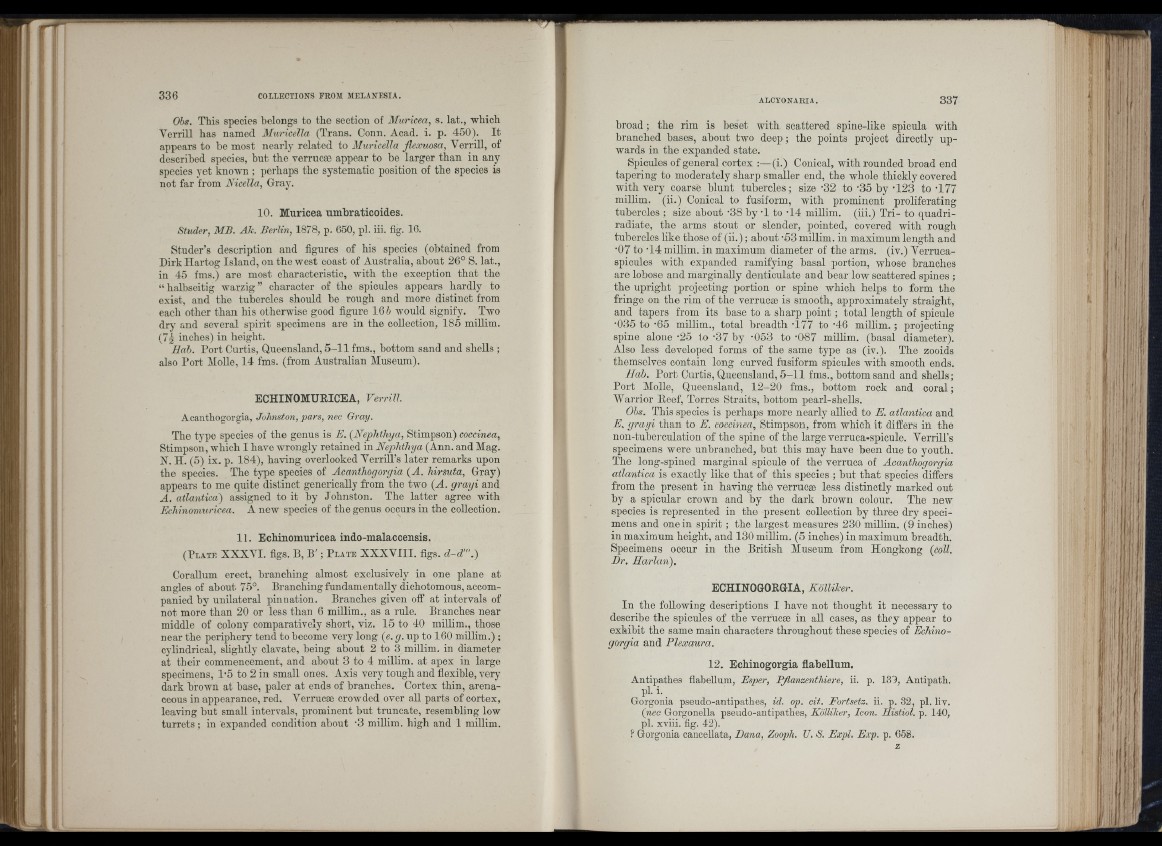
s:í
Ohs. This species belongs to the section of Aiuricea, s. lat., which
Verrill has named Muricella (Trans. Conn. Acad. i. p. 450). I t
appears to be most nearly related to Muricella flexuosa, Verrill, of
described species, but the verriicse appear to be larger than iu any
species yet known ; perhaps the systematic position of the species is
not far from Nicella, Graj".
10. Muricea umhraticoides.
Studer, AIB. Ak. Berlin, 1878, p. 650, pi. iii. fig. 16.
Studer’s description and figures of his species (ohtained from
Dirk Hartog Island, on the west coast of Australia, about 26° S. lat.,
in 45 fms.) are most characteristic, with the exception th a t the
“ halhseitig warzig” character of the spicules appears hardly to
exist, and the tubercles should he rough and more distinct from
each other than his otherwise good figure 16 h would signify. Two
dry and several spirit specimens ai’e in the collection, 185 miUim.
( 7 | inches) in height.
Hah. Port Curtis, Queensland, 5 -11 fms., bottom sand and shells ;
also Port Molle, 14 fms. (from Australian Museum).
ECHINOMURICEA, Verrill.
Acanthogorgia, Johnston, pars, nec Gray.
The type species of the genus is E. (Nephthya, Stimpson) coccinea,
Stimpson, which I have wrongly retained in Nephthya (Ann. and Mag.
N. H. (5) ix. p. 184), having overlooked Verrill’s later remarks upon
the species. The type species of Acanthogorgia (A. hirsuta. Gray)
appears to me quite distinct generically from the two (A. grayi and
A . ntlantica) assigned to it by Johnston. The latter agree with
Echinomuricea. A new species of the genus occurs in the collection.
11. Echinomuricea indo-malaccensis.
( P l a t e XXXVI. figs. B, B' ; P l a t e XX XV III. figs. cl-cl'".)
Corallum erect, branching almost exclusively in one plane at
angles of about 75°. Branching fundamentally dichotomous, accompanied
by unilateral pinnation. Branches given off at intervals of
not more than 20 or less than 6 millim., as a rule. Branches near
middle of colony comparatively short, viz. 15 to 40 millim., those
near the periphery tend to become very long (e. g. up to 160 millim.) ;
cylindrical, slightly clavate, being about 2 to 3 millim. in diameter
at their commencement, and about 3 to 4 millim. at apex in large
specimens, 1’5 to 2 in small ones. Axis very tough and flexible, very
dark brown at base, paler at ends of branches. Cortex thin, arenaceous
in appearance, red. Verrucæ crowded over all parts of cortex,
leaving but small intervals, prominent hnt truncate, resembling low
tu rre ts; in expanded condition about ‘3 millim. high and 1 millim.
b ro ad ; the rim is beset with scattered spine-like spicula with
branched bases, about two deep; the points project directly upwards
in the expanded state.
Spicules of general cortex :—(i.) Conical, with rounded broad end
tapering to moderately sharp smaller end, the whole thickly covered
with very coarse blunt tubercles; size -32 to -35 by '123 to -177
millim. (ii.) Conical to fusiform, with prominent proliferating
tubercles ; size about -38 by -I to -14 millim. (iii.) Tri- to quadri-
radiate, the arms stout or slender, pointed, covered with rough
tubercles like those of (ii.); about -53 millim. in maximum length and
•07 to -14 millim. in maximum diameter of the arms, (iv.) Verruca-
spicules with expanded ramifying hasal portion, whose branches
are lohose and marginally denticulate and bear low scattered spines ;
the upright projecting portion or spine which helps to form the
fringe on the rim of the verrucae is smooth, approximately straight,
and tapers from its base to a sharp p o in t; total length of spicule
•035 to -65 millim., total breadth -177 to -46 millim.; projecting
spine alone -25 to -37 by -053 to ‘087 millim. (basal diameter).
Also less developed forms of the same type as (iv.). The zooids
themselves contain long curved fusiform spicules with smooth ends.
Hah. Port Curtis, Queensland, 5-11 fms., bottom sand and shells;
Port Molle, Queensland, 12-20 fms., bottom rock and c o ra l;
Warrior Reef, Torres Straits, bottom pearl-shells.
Ohs. This species is perhaps more nearly allied to E. atlantica and
E. grayi than to E. coccinea, Stimpson, from which it differs in the
non-tubei'culation of the spine of the large verruca-spicule. Verrill’s
specimens were unhranched, but this may have been due to youth.
The long-spiiied marginal spicule of the verruca of Acanthogorgia
atlantica is exactly like th at of this species ; hut th at species differs
from the present in having the verrucae less distinctly marked out
by a spicular crown and by the dark brown colour. The new
species is represented in the present collection by three dry specimens
and one in s p ir it; the largest measures 230 millim. (9 inches)
in maximum height, and 130 millim. (5 inches) in maximum breadth.
Specimens occur in the British Museum from Hongkong (coll.
Dr. Harlan).
ECHINOGORGIA, Kdllilcer.
In the foUowing descriptions I have not thought it necessary to
describe the spicules of the verrucae in aU cases, as they appear to
exhibit the same main characters throughout these species of Echino-
gorgia and Plexaura.
12. Echinogorgia flahellum.
Antipathes flabellum, Esper, PJlanzenthiere, ii. p. 139, Antipath.
ph I . Gorgonia pseudo-antipathes, id. op. cit. Eortsetz. ii. p. 32, pi. liv.
(nec Gorgonella pseudo-antipathes, Kolliker, Icon. Uistiol. p. 140,
pi. xviii. fig. 42).
? Gorgonia cancellata, Dana, Zooph. U. S. Expl. Exp. p. 658.
z
T' i i t
iO ' ¡5
I
!
I
l i ' ,
M I. 'h " i: i”'
I
i! 4'
ill
l i!